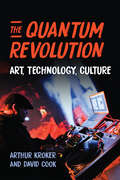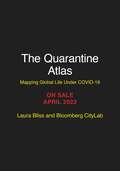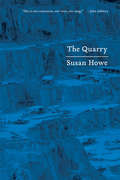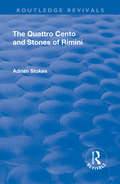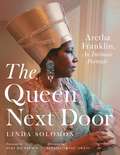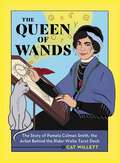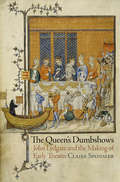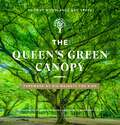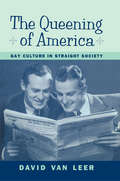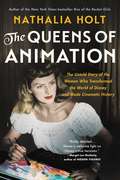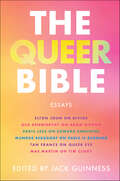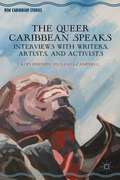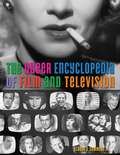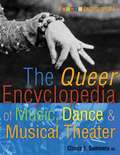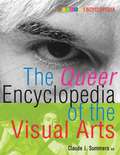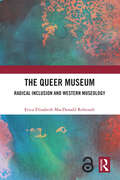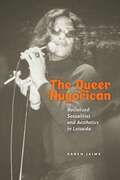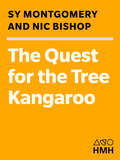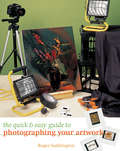- Table View
- List View
The Quantum Revolution: Art, Technology, Culture (Digital Futures)
by David Cook Arthur KrokerWe are currently riders of the information storm. AI fascinates us, images mesmerize us, data defines us, algorithms remember us, news bombards us, devices connect us, isolation saddens us. Deeply embedded in digital technology, we are the very first inhabitants of life in the quantum zone. The Quantum Revolution is about life today – its entanglements, creativity, politics, and artistic vision. Arthur Kroker and David Cook explore a new way of thinking drawn directly from the quantum imaginary itself. They explain the quantum revolution as everyday life, where technology moves fast, and where, under cover of the digital devices that connect us, the most sophisticated concepts of technology and science originating in mathematics, astrophysics, and biogenetics have swiftly flooded human consciousness, shaped social behavior, and crafted individual identity. The book discusses the concept of the quantum zone as a new way of understanding digital culture, and presents stories about art, technology, and society, as well as a series of reflections on art as a gateway to understanding the quantum imaginary. Richly illustrated with sixty images of critically engaged photos and artwork, The Quantum Revolution privileges a new way of understanding and seeing politics, society, and culture through the lens of the duality that is the essence of the quantum imaginary.
The Quarantine Atlas: Mapping Global Life Under COVID-19
by Laura Bliss A Bloomberg CityLab ProjectThe Quarantine Atlas is a poignant and deeply human collection of more than 65 homemade maps created by people around the globe that reveal how the coronavirus pandemic has transformed our physical and emotional worlds, in ways both universal and unique. Along with eight original essays, it is a vivid celebration of wayfinding through a crisis that irrevocably altered the way we experience our environment.In April 2020, Bloomberg CityLab journalists Laura Bliss and Jessica Lee Martin asked readers to submit homemade maps of their lives during the coronavirus pandemic. The response was illuminating and inspiring. The 400+ maps and accompanying stories received served as windows into what individuals around the world were experiencing during the crisis and its resonant social consequences. Collectively, these works showed how coronavirus has transformed the places we live, and our relationships to them.In The Quarantine Atlas, Bliss distills these stunning submissions and pairs them with essays by journalists and authors, as well as notes from the original mapmakers. The result is an enduring visual record of this unprecedented moment in human history. It is also a celebration of the act of mapping and the ways maps can help us connect and heal from our shared experience.
The Quarry: Essays
by Susan HoweThe Quarry presents new and pivotal Susan Howe prose pieces. A powerful selection of Susan Howe's key essays, The Quarry moves backward chronologically, from her brand-new "Vagrancy in the Park" (about Wallace Stevens) through essential texts such as "The Disappearance Approach," "Personal Narrative," "Sorting Facts; or, 47 Ways of Looking at Chris Marker," "Frame Structures," and "Where Should the Commander Be" to end with her seminal early art criticism, "The End of Art."
The Quattro Cento and Stones of Rimini: A Different Conception of the Italian Renaissance
by Adrian StokesThis title was first published in 2002. Adrian Stokes was a British painter and writer whose books on art have been allowed to go out of print despite their impact on Modernist culture. This new edition of The Quattro Cento and The Stones of Rimini presents the original texts of 1932 and 1934 and furnishes them with introductions by David Carrier and Stephen Kite that will help readers grasp the structure and significance of what have become Stokes' most widely cited and influential books. Written as parts of an incomplete trilogy, The Quattro Cento and The Stones of Rimini mark a crossroad in the transition from late Victorian to Modernist conceptions of art, especially sculpture and architecture. Stokes continued, even expanded, John Ruskin's and Walter Pater's belief that art is essential to the individual's proper psychological development but wove their teaching into a new aesthetic shaped by his experience of psychoanalysis and recent innovations in literature, dance, and the visual arts. This volume will be of interest to those concerned with art criticism, aesthetics and psychoanalysis, as well as the art and architecture of the Renaissance and Modern periods. Supported by the Henry Moore Foundation in memory of David Sylvester.
The Quay Brothers: Into a Metaphysical Playroom
by Suzanne BuchanThis work is the first thorough analysis of the creative oeuvre of the Quay Brothers. Known for their animation shorts that rely on puppetry, miniatures, and stop-motion techniques, their fiercely idiosyncratic films are fertile fields for Suzanne Buchan's engaging descriptions and provocative insights into the Quays' art-and into the art of independent puppet animation.Buchan's aesthetic investigation stems from extensive access to the Quay Brothers' artistic practices and work, which spans animation and live-action film, stage design and illustration. She also draws on a long acquaintance with them and on interviews with collaborators essential to their productions, as well as archival sources. Discussions of their films' literary origins, space, puppets, montage, and the often-overlooked world of sound and music in animation shed new light on the expressive world that the Quay Brothers generate out of their materials to create the poetic alchemy of their films.At once a biography of the Quays' artistic trajectory and a detailed examination of one of their best-known films, Street of Crocodiles, this book goes further and provides interdisciplinary methodologies and tools for the analysis of animation.
The Queen Next Door: Aretha Franklin, An Intimate Portrait (Painted Turtle)
by Linda Solomon"Aretha was private. I respected this and she trusted me." Linda Solomon met Aretha Franklin in 1983 when she was just beginning her career as a photojournalist and newspaper columnist. Franklin’s brother and business manager arranged for Solomon to capture the singer’s major career events—just as she was coming back home to Detroit from California—while Franklin requested that Solomon document everything else. Everything. And she did just that. What developed over these years of photographing birthday and Christmas parties in her home, annual celebrity galas, private backstage moments during national awards ceremonies, photo shoots with the iconic pink Cadillac, and more was a friendship between two women who grew to enjoy and respect one another. The Queen Next Door: Aretha Franklin, An Intimate Portrait is a book full of firsts as Solomon was invited not only to capture historical events in Aretha’s music career showcasing Detroit but to join in with the Franklin family’s most intimate and cherished moments in her beloved hometown. From performance rehearsals with James Brown to off-camera shenanigans while filming a music video with the Rolling Stones, from her first television special to her first time performing with the Detroit Symphony Orchestra, to her last performance with her sisters at her father’s church and her son’s college graduation celebration. In the book’s afterword, Sabrina Vonne' Owens, Franklin’s niece, honors her aunt, a woman who was an overwhelming supporter of civil rights, women’s rights, and fundraising campaigns that helped to benefit her hometown. There was a time in her career—when Franklin was more in demand than ever before—when she insisted that if someone wanted her to perform, they had to come to Detroit. During this time all of her major concerts, national television specials, music videos, and commercials would happen in Detroit. Aretha Franklin showed her respect for the people in the city who championed her from the very beginning when she started singing as a young girl in the church choir. Franklin used to say, "I am the lady next door when I am not on stage." The Queen Next Door offers fans a personal and unseen look at an extraordinary woman in her most natural moments—both regal and intimate—and highlights her devotion to her family and her hometown Detroit—"forever and ever."
The Queen of Wands: The Story of Pamela Colman Smith, the Artist Behind the Rider-Waite Tarot Deck
by Cat WillettDiscover the life, work, and magic of Pamela Colman Smith, the visionary artist behind the Rider-Waite-Smith Tarot Deck, the most popular and renowned divination deck in the world. With rich imagery, stunning colors, and an iconic place in the realm of divination, the Rider-Waite Tarot is perhaps the best known deck in the world. Seasoned readers and fledgling diviners alike turn to these cards in search of inspiration, understanding, and even a hint at the future. But the story of their origin is less well known, with their brilliant creator's name stripped away from them for decades. Now, for the first time, mystics, art-lovers, and fortune-tellers will uncover the magical story of Pamela Coleman Smith, rendered in full-color illustrations by artist Cat Willett, and inspired by the work of Pamela herself. From a childhood spent between the United Kingdom and Jamaica, to early artistic success in New York, to involvement in the secret occult society Order of the Golden Dawn, Pamela -- or Pixie, as she was known to many -- had a life full of enchanted inspiration and profound hardship. Through it all, her art acted as a guiding force, culminating in her custom illustrations for the deck that would become the Rider-Waite Tarot. Though she received little money and almost no credit for her contributions to the magical realm in her lifetime, Pixie's impact on tarot, divination, and the worlds of mysticism and the arts have reverberated for nearly 150 years, and her story serves as an enchanted spark. Depicted in whimsical, full-color detail, with interludes tying Pamela to the resurgence of modern magic and the world of tarot throughout, this singular work is a must-read for witches, creatives, and activists.
The Queen's Dumbshows
by Claire SponslerNo medieval writer reveals more about early English drama than John Lydgate, Claire Sponsler contends. Best known for his enormously long narrative poems The Fall of Princes and The Troy Book, Lydgate also wrote numerous verses related to theatrical performances and ceremonies. This rich yet understudied body of material includes mummings for London guildsmen and sheriffs, texts for wall hangings that combined pictures and poetry, a Corpus Christi procession, and entertainments for the young Henry VI and his mother.In The Queen's Dumbshows, Sponsler reclaims these writings to reveal what they have to tell us about performance practices in the late Middle Ages. Placing theatricality at the hub of fifteenth-century British culture, she rethinks what constituted drama in the period and explores the relationship between private forms of entertainment, such as household banquets, and more overtly public forms of political theater, such as royal entries and processions. She delineates the intersection of performance with other forms of representation such as feasts, pictorial displays, and tableaux, and parses the connections between the primarily visual and aural modes of performance and the reading of literary texts written on paper or parchment. In doing so, she has written a book of signal importance to scholars of medieval literature and culture, theater history, and visual studies.
The Queen's Green Canopy: Ancient Woodlands and Trees
by Adrian Houston Charles Sainsbury-PlaiceStunning photographs of the United Kingdom's most spectacular trees - with a foreword by His Majesty the King.The Queen's Green Canopy is a beautiful photography book showcasing 70 ancient trees and 70 ancient woodlands dedicated by the QGC initiative in honour of Her Majesty's Platinum Jubilee.The book features extraordinary photographs of the United Kingdom's best-loved trees, many of which inspired historic figures, artists and writers through the centuries.Alongside these photographs are short written pieces from contributors including Dame Judi Dench, Alan Titchmarsh, Dame Joanna Lumley, Adam Henson, Archbishop Justin Welby and Danny Clarke, as well as conservation experts from the Woodland Trust and the Duchy of Cornwall. In these pieces they reflect on the trees that have made a mark on their lives and the importance of protecting Britain's woodlands for future generations.Selected trees include yews at a Cotswold's church which inspired JRR Tolkien; the apple tree believed to have inspired Sir Isaac Newton's theory of gravity; the Five Hundred Acre Wood in East Sussex immortalised in AA Milne's Winnie the Pooh books; and the 2,500-year-old tree where Henry VIII may have proposed to Anne Boleyn.So far 3 million trees have been planted by communities, schools and businesses across the country as part of the QGC initiative. Through incredible imagery and joyful pieces of writing, The Queen's Green Canopy celebrates Her Majesty's extraordinary life and the amazing legacy she leaves behind.
The Queening of America
by David Van LeerSince at least the end of the nineteenth century, gay culture - its humour, its icons, its desires - has been alive and sometimes even visible in the midst of straight American society. David Van Leer puts forward here a series of readings that aim to identify what he calls the "queening" of America, a process by which "rhetorics and situations specific to homosexual culture are presented to a general readership as if culturally neutral." The Queening of America examines how the invisibility of gay male writing, especially in the popular culture of the 1950s and 1960s, facilitated the crossing of gay motifs in straight culture. Van Leer then critiques some current models of making homosexuality visible (the packaging of Joe Orton, the theories of Eve Kosofsky Sedgwick, the rise of gay studies), before concluding more optimistically with the possible alliances between gay culture and other minority discourses.
The Queens of Animation: The Untold Story of the Women Who Transformed the World of Disney and Made Cinematic History
by Nathalia HoltFrom the bestselling author of Rise of the Rocket Girls, the untold, "richly detailed" story of the women of Walt Disney Studios, who shaped the iconic films that have enthralled generations (Margot Lee Shetterly, New York Times bestselling author of Hidden Figures) From Snow White to Moana, from Pinocchio to Frozen, the animated films of Walt Disney Studios have moved and entertained millions. But few fans know that behind these groundbreaking features was an incredibly influential group of women who fought for respect in an often ruthless male-dominated industry and who have slipped under the radar for decades. In The Queens of Animation, bestselling author Nathalia Holt tells their dramatic stories for the first time, showing how these women infiltrated the boys' club of Disney's story and animation departments and used early technologies to create the rich artwork and unforgettable narratives that have become part of the American canon. As the influence of Walt Disney Studios grew---and while battling sexism, domestic abuse, and workplace intimidation---these women also fought to transform the way female characters are depicted to young audiences.With gripping storytelling, and based on extensive interviews and exclusive access to archival and personal documents, The Queens of Animation reveals the vital contributions these women made to Disney's Golden Age and their continued impact on animated filmmaking, culminating in the record-shattering Frozen, Disney's first female-directed full-length feature film.
The Queens of New York: A Novel
by E. L. ShenFrom acclaimed author E. L. Shen comes a sun-drenched, cinematic YA novel about three Asian American girls, their unbreakable bond, and one life-changing summer, perfect for fans of The Sisterhood of the Traveling Pants.Best friends Jia Lee, Ariel Kim, and Everett Hoang are inseparable. But this summer, they won’t be together.Everett, aspiring Broadway star, hopes to nab the lead role in an Ohio theater production, but soon realizes that talent and drive can only get her so far. Brainy Ariel is flying to San Francisco for a prestigious STEM scholarship, even though her heart is in South Korea, where her sister died last year. And stable, solid Jia will be home in Flushing, juggling her parents’ Chinatown restaurant, a cute new neighbor, and dreams for an uncertain future.As the girls navigate heartbreaking surprises and shocking self-discoveries, they find that even though they’re physically apart, they are still mighty together.
The Queer Aesthetics of Childhood: Asymmetries of Innocence and the Cultural Politics of Child Development (Rutgers Series in Childhood Studies)
by Hannah DyerIn The Queer Aesthetics of Childhood, Hannah Dyer offers a study of how children’s art and art about childhood can forecast new models of social life that redistribute care, belonging, and political value. Dyer suggests that childhood’s cultural expressions offer insight into the persisting residues of colonial history, nation building, homophobia, and related violence. Drawing from queer and feminist theory, psychoanalysis, settler-colonial studies, and cultural studies, this book helps to explain how some theories of childhood can hurt children. Dyer’s analysis moves between diverse sites and scales, including photographs and an art installation, children’s drawings after experiencing war in Gaza, a novel about gay love and childhood trauma, and debates in sex-education. In the cultural formations of art, she finds new theories of childhood that attend to the knowledge, trauma, fortitude and experience that children might possess. In addressing aggressions against children, ambivalences towards child protection, and the vital contributions children make to transnational politics, she seeks new and queer theories of childhood.
The Queer Bible: Essays
by Jack GuinnessAn O, The Oprah Magazine LGBTQ Book "Changing the Literary Landscape"A gorgeously illustrated collection of essays written by today’s queer heroes—featuring contributions from Elton John, Tan France, Gus Kenworthy, Paris Lees, Russell Tovey, Munroe Bergdorf, and many others. The Queer Bible is a celebration of LGBTQ+ history and culture, edited by model, performer, and GQ contributing editor Jack Guinness.Our queer heroes write about theirs.In 2016, model and queer activist Jack Guinness decided that the LGBTQ+ community desperately needed to be reminded of its long and glorious history of stardom—and he was spurred to action. The following year, QueerBible.com was born, an online community devoted to celebrating queer heroes, both past and present. “So much queer history is hidden or erased,” says Guinness. “The Queer Bible is a home for all those personal stories and histories.” In this book, contemporary queer heroes pay homage to those who helped pave their paths. Contributors include Vogue columnist Paris Lees (writing on Edward Enninful), singer and songwriter Elton John (writing on Divine), comedian Mae Martin (writing on Tim Curry), author Joseph Cassara (writing on Pedro Almodóvar), and many others, honoring timeless queer icons such as Susan Sontag, David Bowie, Sylvester, RuPaul, and George Michael through illuminating essays paired with stunning illustrations. The Queer Bible is a powerful and intimate essay collection of gratitude, and an essential, enduring love letter to the queer community. We stand on the shoulders of giants. Now we praise their names.
The Queer Caribbean Speaks
by Kofi Omoniyi Sylvanus CampbellIn most Caribbean countries homosexuality is still illegal and many outside of the region are unaware of how difficult life can be for gay men and lesbians. This book collects interviews with queer Caribbean writers, activists, and citizens and challenges the dominance of Euro-American theories in understanding global queerness.
The Queer Encyclopedia of Film and Television
by Claude SummersFrom Hollywood films to TV soap operas, from Vegas extravaganzas to Broadway theater to haute couture, this comprehensive encyclopedia contains over 200 entries and 200 photos that document the irrepressible impact of queer creative artists on popular culture. How did Liberace’s costumes almost kill him? Which lesbian comedian spent her high school years as “the best white cheerleader in Detroit?” For these answers and more, fans can dip into The Queer Encyclopedia of Film, Theater, and Popular Culture. Drawn from the fascinating online encyclopedia of queer arts and culture, www.glbtq.com — which the Advocate dubbed “the Encyclopedia Brittaniqueer” — this may be the only reference book in which RuPaul and Jean Cocteau jostle for space. From the porn industry to the Sisters of Perpetual Indulgence, from bodybuilding to Dorothy Arzner, it’s a queer, queer world, and The Queer Encyclopedia is the indispensable guide: readable, authoritative, and concise. And perfect to read by candelabra. (The answers to the two questions above: from the dry cleaning fumes, Lily Tomlin.)
The Queer Encyclopedia of Music, Dance, and Musical Theater
by Claude SummersAficionados of music, dance, opera, and musical theater will relish this volume featuring over 200 articles showcasing composers, singers, musicians, dancers, and choreographers across eras and styles. Read about Hildegard of Bingen, whose Symphonia expressed both spiritual and physical desire for the Virgin Mary, and George Frideric Handel, who not only created roles for castrati but was behind the Venetian opera's preoccupations with gender ambiguity. Discover Alban Berg’s Lulu, opera’s first openly lesbian character. And don’t forget Kiss Me Kate, the hit 1948 Broadway musical: written by Cole Porter, married though openly gay; directed by John C. Wilson, Noël Coward's ex-lover; and featuring Harold Lang, who had affairs with Leonard Bernstein and Gore Vidal. No single volume has ever achieved the breadth of this scholarly yet eminently readable compendium. It includes overviews of genres as well as fascinating biographical entries on hundreds of figures such as Peter Tchaikovsky, Maurice Ravel, Sergei Diaghilev, Bessie Smith, Aaron Copland, Stephen Sondheim, Alvin Ailey, Rufus Wainwright, and Ani DiFranco.
The Queer Encyclopedia of the Visual Arts
by Claude SummersA distinctly queer presence permeates the history of the visual arts — from Michelangelo's David and homoerotic images on ancient Greek vases to Frida Kahlo's self-portraits and the photography of Claude Cahun and Robert Mapplethorpe. The Queer Encyclopedia of the Visual Arts is a comprehensive work showcasing the enormous contribution of gay, lesbian, bisexual, transgender, and queer artists to painting, drawing, photography, printmaking, sculpture, and architecture. International in scope, the volume includes overviews of the various periods in art history, from Classical Art to Contemporary Art and from African Art to Erotic and Pornographic Art; discussions of topics ranging from AIDS Activism in the Arts, Censorship in the Arts, and the Arts and Crafts Movement to Pulp Paperbacks and Their Covers; surveys of the representation of various subjects in the visual arts, from Androgyny to Vampires; and biographical entries on significant figures in the history of art, such as Andy Warhol, Keith Haring, El Greco, Leonardo da Vinci, David Hockney, Ruth Bernhard, Rosa Bonheur, Romaine Brooks, Simeon Solomon, and Nahum Zenil. Includes more than 100 illustrations and photographs.
The Queer Fantasies of the American Family Sitcom
by Tison PughThe Queer Fantasies of the American Family Sitcom examines the evasive depictions of sexuality in domestic and family-friendly sitcoms. Tison Pugh charts the history of increasing sexual depiction in this genre while also unpacking how sitcoms use sexuality as a source of power, as a kind of camouflage, and as a foundation for family building. The book examines how queerness, at first latent, became a vibrant yet continually conflicted part of the family-sitcom tradition. Taking into account elements such as the casting of child actors, the use of and experimentation with plot traditions, the contradictory interpretive valences of comedy, and the subtle subversions of moral standards by writers and directors, Pugh points out how innocence and sexuality conflict on television. As older sitcoms often sit on a pedestal of nostalgia as representative of the Golden Age of the American Family, television history reveals a deeper, queerer vision of family bonds.
The Queer Girl is Going to Be Okay
by Dale WallsPublishers Weekly Best of the Year Queer Love. Something Dawn wants, desperately, but does not have. But maybe, if she can capture it, film it, interview the people who have it, queer love will be hers someday. Or, at least, she'll have made a documentary about it. A documentary that, hopefully, will win Dawn a scholarship to film school. Many obstacles stand in the way of completing her film, but her best friends Edie and Georgia are there to help her reach her goal, no matter what it takes. A touching and joyous story of queer friendship and girlhood set in the vibrant city of Houston, THE QUEER GIRL IS GOING TO BE OKAY will make you laugh, make you cry, and make you believe that eventually, everything will be okay.
The Queer Museum: Radical Inclusion and Western Museology
by Erica RobenaltThe Queer Museum examines how relationships between institutions and LGBTQ+ communities function and how they help to define queer museum practice.Analysing what it means to queer the museum in Western contexts, the book builds upon and challenges texts about inclusionary, activist museum practice and discusses the ways in which Othered communities are engaged with and represented. Arguing that an institution’s understanding of queerness is directly related to the kind, and extent, of change pursued by the museum, the author clarifies that governance structures, staff hierarchies, funding and relationships to queer communities affect the way queering might be pursued. The analysis looks critically at exhibitions and institutions and particularly forefronts the experiences of museum practitioners. It argues that practical changes that positively affect museums’ long-term relationships with marginalised communities are critical. The book also considers the future of the museum by drawing on queer theories of utopia, futurity, failure and amateurism to complicate understandings of the queer museum and its relationship to people and objects.The Queer Museum will be of interest to students and academics in museum and heritage studies, art history and archival studies. It will also be essential reading for museum and arts sector practitioners who seek to do and engage with this kind of work.
The Queer Nuyorican: Racialized Sexualities and Aesthetics in Loisaida (Performance and American Cultures #4)
by Karen JaimeFinalist for The Barnard Hewitt Award for Outstanding Research in Theatre History, given by the American Society for Theatre Research.Silver Medal Winner of The Victor Villaseñor Best Latino Focused Non-Fiction Book Award, given by the International Latino Book Awards.Honorable Mention for the Best LGBTQ+ Themed Book, given by the International Latino Book Awards.A queer genealogy of the famous performance space and the nuyorican aesthetic One could easily overlook the Nuyorican Poets Cafe, a small, unassuming performance venue on New York City’s Lower East Side. Yet the space once hosted the likes of Victor Hernández Cruz, Allen Ginsberg, and Amiri Baraka and is widely credited as the homespace for the emergent nuyorican literary and aesthetic movement of the 1990s. Founded by a group of counterculturalist Puerto Rican immigrants and artists in the 1970s, the space slowly transformed the Puerto Rican ethnic and cultural associations of the epithet “Nuyorican,” as the Cafe developed into a central hub for an artistic movement encompassing queer, trans, and diasporic performance. The Queer Nuyorican is the first queer genealogy and critical study of the historical, political, and cultural conditions under which the term “Nuyorican” shifted from a raced/ethnic identity marker to “nuyorican,” an aesthetic practice. The nuyorican aesthetic recognizes and includes queer poets and performers of color whose writing and performance build upon the politics inherent in the Cafe’s founding. Initially situated within the Cafe’s physical space and countercultural discursive history, the nuyorican aesthetic extends beyond these gendered and ethnic boundaries, broadening the ethnic marker Nuyorican to include queer, trans, and diasporic performance modalities. Hip-hop studies, alongside critical race, queer, literary, and performance theories, are used to document the interventions made by queer and trans artists of color—Miguel Piñero, Regie Cabico, Glam Slam participants, and Ellison Glenn/Black Cracker—whose works demonstrate how the Nuyorican Poets Cafe has operated as a queer space since its founding. In focusing on artists who began their careers as spoken word artists and slam poets at the Cafe, The Queer Nuyorican examines queer modes of circulation that are tethered to the increasing visibility, commodification, and normalization of spoken word, slam poetry, and hip-hop theater in the United States and abroad.
The Queer Sixties
by Patricia Juliana SmithThe Queer Sixties assembles an impressive group of cultural critics to go against the grain of 1960s studies, and proposes new and different ways of the last decade before the closet doors swung open. Imbued with the zeitgeist of the 60s, this playful and powerful collection rescues the persistence of the queer imaginary.
The Quest for the Tree Kangaroo: An Expedition to the Cloud Forest of New Guinea (Scientists in the Field Series)
by Sy Montgomery Nic Bishop<P>It looks like a bear, but isn't one. It climbs trees as easily as a monkey- but isn't a monkey, either. It has a belly pocket like a kangaroo, but what's a kangaroo doing up a tree? Meet the amazing Matschie's tree kangaroo, who makes its home in the ancient trees of Papua New Guinea's cloud forest. And meet the amazing scientists who track these elusive animals. <P>[This text is listed as an example that meets Common Core Standards in English language arts in grades 4-5 at http://www.corestandards.org.] <P><P> Winner of the Sibert Honor
The Quick & Easy Guide to Photographing Your Artwork
by Roger SaddingtonShoot your work like a pro!Whether you're entering your paintings in an art show, compiling your portfolio or simply documenting your art, you need flawless pictures of your work. But how do you get professional slides without buying expensive equipment or paying a photographer?With The Quick & Easy Guide to Photographing Your Artwork, you'll learn how to use materials you already own to produce quality slides of your art. Photographer, artist and teacher Roger Saddington shows you:What kind of camera, light and film to use for optimum resultsHow to capture the nature of your work, whether it's two- or three-dimensional or has other unique qualitiesThe best way to set up a studioHow to avoid common problems such as poor framing, camera shake, glare, color casts and more!In The Quick & Easy Guide to Photographing Your Artwork, you'll find all the secrets and surefire methods you need to produce professional, accurate slides and prints of your art.
